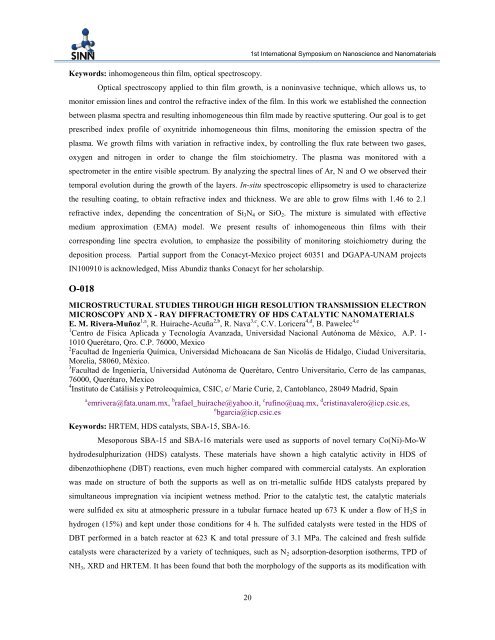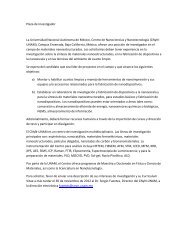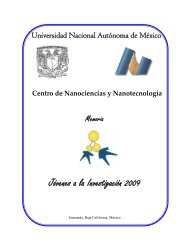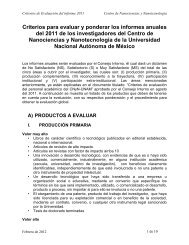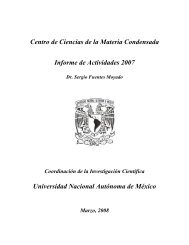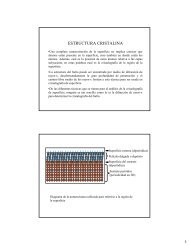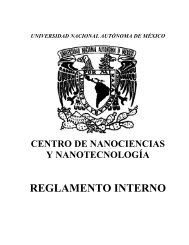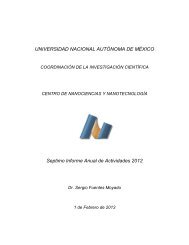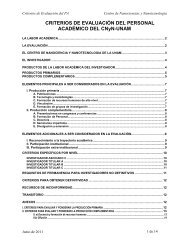Universidad Nacional Autónoma de México - CNyN
Universidad Nacional Autónoma de México - CNyN
Universidad Nacional Autónoma de México - CNyN
You also want an ePaper? Increase the reach of your titles
YUMPU automatically turns print PDFs into web optimized ePapers that Google loves.
1st International Symposium on Nanoscience and Nanomaterials<br />
Keywords: inhomogeneous thin film, optical spectroscopy.<br />
Optical spectroscopy applied to thin film growth, is a noninvasive technique, which allows us, to<br />
monitor emission lines and control the refractive in<strong>de</strong>x of the film. In this work we established the connection<br />
between plasma spectra and resulting inhomogeneous thin film ma<strong>de</strong> by reactive sputtering. Our goal is to get<br />
prescribed in<strong>de</strong>x profile of oxynitri<strong>de</strong> inhomogeneous thin films, monitoring the emission spectra of the<br />
plasma. We growth films with variation in refractive in<strong>de</strong>x, by controlling the flux rate between two gases,<br />
oxygen and nitrogen in or<strong>de</strong>r to change the film stoichiometry. The plasma was monitored with a<br />
spectrometer in the entire visible spectrum. By analyzing the spectral lines of Ar, N and O we observed their<br />
temporal evolution during the growth of the layers. In-situ spectroscopic ellipsometry is used to characterize<br />
the resulting coating, to obtain refractive in<strong>de</strong>x and thickness. We are able to grow films with 1.46 to 2.1<br />
refractive in<strong>de</strong>x, <strong>de</strong>pending the concentration of Si 3 N 4 or SiO 2 . The mixture is simulated with effective<br />
medium approximation (EMA) mo<strong>de</strong>l. We present results of inhomogeneous thin films with their<br />
corresponding line spectra evolution, to emphasize the possibility of monitoring stoichiometry during the<br />
<strong>de</strong>position process. Partial support from the Conacyt-Mexico project 60351 and DGAPA-UNAM projects<br />
IN100910 is acknowledged, Miss Abundiz thanks Conacyt for her scholarship.<br />
O-018<br />
MICROSTRUCTURAL STUDIES THROUGH HIGH RESOLUTION TRANSMISSION ELECTRON<br />
MICROSCOPY AND X - RAY DIFFRACTOMETRY OF HDS CATALYTIC NANOMATERIALS<br />
E. M. Rivera-Muñoz 1,a , R. Huirache-Acuña 2,b , R. Nava 3,c , C.V. Loricera 4,d , B. Pawelec 4,e<br />
1 Centro <strong>de</strong> Física Aplicada y Tecnología Avanzada, <strong>Universidad</strong> <strong>Nacional</strong> Autónoma <strong>de</strong> México, A.P. 1-<br />
1010 Querétaro, Qro. C.P. 76000, Mexico<br />
2 Facultad <strong>de</strong> Ingeniería Química, <strong>Universidad</strong> Michoacana <strong>de</strong> San Nicolás <strong>de</strong> Hidalgo, Ciudad Universitaria,<br />
Morelia, 58060, México.<br />
3 Facultad <strong>de</strong> Ingeniería, <strong>Universidad</strong> Autónoma <strong>de</strong> Querétaro, Centro Universitario, Cerro <strong>de</strong> las campanas,<br />
76000, Querétaro, Mexico<br />
4 Instituto <strong>de</strong> Catálisis y Petroleoquímica, CSIC, c/ Marie Curie, 2, Cantoblanco, 28049 Madrid, Spain<br />
a emrivera@fata.unam.mx, b rafael_huirache@yahoo.it, c rufino@uaq.mx, d cristinavalero@icp.csic.es,<br />
e bgarcia@icp.csic.es<br />
Keywords: HRTEM, HDS catalysts, SBA-15, SBA-16.<br />
Mesoporous SBA-15 and SBA-16 materials were used as supports of novel ternary Co(Ni)-Mo-W<br />
hydro<strong>de</strong>sulphurization (HDS) catalysts. These materials have shown a high catalytic activity in HDS of<br />
dibenzothiophene (DBT) reactions, even much higher compared with commercial catalysts. An exploration<br />
was ma<strong>de</strong> on structure of both the supports as well as on tri-metallic sulfi<strong>de</strong> HDS catalysts prepared by<br />
simultaneous impregnation via incipient wetness method. Prior to the catalytic test, the catalytic materials<br />
were sulfi<strong>de</strong>d ex situ at atmospheric pressure in a tubular furnace heated up 673 K un<strong>de</strong>r a flow of H 2 S in<br />
hydrogen (15%) and kept un<strong>de</strong>r those conditions for 4 h. The sulfi<strong>de</strong>d catalysts were tested in the HDS of<br />
DBT performed in a batch reactor at 623 K and total pressure of 3.1 MPa. The calcined and fresh sulfi<strong>de</strong><br />
catalysts were characterized by a variety of techniques, such as N 2 adsorption-<strong>de</strong>sorption isotherms, TPD of<br />
NH 3 , XRD and HRTEM. It has been found that both the morphology of the supports as its modification with<br />
20


